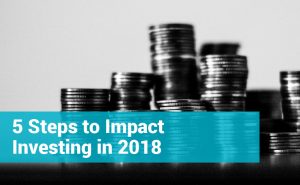Impact investing rose to prominence in a big way during 2017. Two major impact investing conferences – SOCAP and TBLI – celebrated milestones, and the Global Impact Investing Network’s Annual Impact Investor Survey 2017 showed promising momentum for the industry.
If you haven’t thought too much about the impact of your portfolio, now is the time. The market is growing, and social entrepreneurs are finding new and more innovative ways to provide stronger financial returns alongside measurable social benefits. Here are some tips to get you started on impact investing.
- 1 – Find Your Focus
Impact investing grew out of earlier investing movements such as ESG Investing – Environmental, Social, and Governance. These refer to three possible areas where investments can make the most impact.
If you are a passionate environmentalist, naturally you’d want to find investments that make an impact on environmental issues. Investments in GreenTech, alternative energy sources, or solutions to climate change are very popular and important.
On the social side, you may want to invest in companies and startups that serve struggling communities. American Homeowner Preservation falls into this category, as our business provides solutions to homeowners at risk of foreclosure.
Governance is more about how companies are run – perhaps you, like AHP investor Marco Vangelisti, are interested in companies that suggest an alternative economic model and might want to invest in worker-owned cooperatives. Or maybe you just want your money to fund companies that are committed to diversity and inclusion.
And of course, there’s nothing wrong with wanting to diversify into multiple, or even all of these areas and more.
- 2 – Cut out the Bad
When deciding how to make an impact with your investments, it’s important to consider both the negative and the positive.
You may want to consider taking a look at all of your investments, especially passive investments and anything put into a 401(k) or IRA, to see if your money is funding anything that might go against your values. You may be invested in fossil fuel companies that pollute the environment, or governmentally questionable companies that exploit their workers or the communities they do business in.
One caution – impact investing should be about more than simply “screening out the bad.” It’s a great idea to take your money out of enterprises that may be having a negative impact, but it’s just as important to then put that money in companies making a positive impact. With that said, it’s time to…
- 3 – Research
This is the time to start looking at what investments are available to you, based on your criteria. The unfortunate reality is that impact investing is still a relatively new area, and information is harder to come by.
ImpactAssets.org is a great resource; they maintain a list called the ImpactAssets 50 that they describe as “An annual showcase of impact investment fund managers.” It lists fifty impactful funds and displays their geographic focus as well as their area of impact (health and wellness, fair trade, education, etc.).
The Global Impact Investing Network (GIIN) also has several resources, the most helpful of which is their “Tools & Training” page. It provides information and suggestions on performance metrics for impact, a specialized training program for new investors, and a database of impactful investments.
As crucial as doing your research is, it is also essential that you…
- 4 – Join the Community
Impact investing is more than just an activity, it’s a community. Because it is still a small world (but rapidly growing!) many prominent impact investors and entrepreneurs are very willing to engage with and help educate those new to impact investing.
You might think about attending a conference – SoCap is the largest impact investing conference in the world, and there are many others to choose from. Attending a conference or other event is a great way to network with other investors and meet scrappy entrepreneurs seeking funding for their innovative solutions to social problems.
There is also a vibrant online community of impact investors – take to social media, especially Facebook and Twitter, and join the conversation. There’s a lot to learn, and a lot of wonderful people to meet.
- 5 – Get to Know Your Investments
Another benefit to the relatively small impact investing community is that by its nature there is a lot of opportunity for personal interaction between investor and entrepreneur. Here at American Homeowner Preservation, for example, we make it a point to communicate with our investors both through general emails and newsletters, as well as more personal means (such as our Investor Spotlight series). We also make sure that our Investor Relations team is always available when investors or potential investors want information or have questions about what we do.
Forging a relationship with entrepreneurs you invest in is the number-one way to ensure that you trust them to prioritize the impact side of their business. Don’t be afraid to ask questions – with impact investing, the character of the entrepreneur can be just as important as their business plan.
2018 is your year to take the final step to become an impact investor. The impact investing community is ideal in that it’s small enough that you’ll feel like you’re a part of something meaningful, and growing quickly enough to be exciting. Don’t wait – start doing well by doing good today.


 440 S LaSalle Street, Suite 1110, Chicago,IL 60605
440 S LaSalle Street, Suite 1110, Chicago,IL 60605




